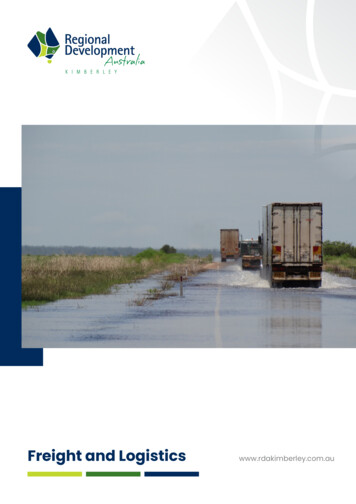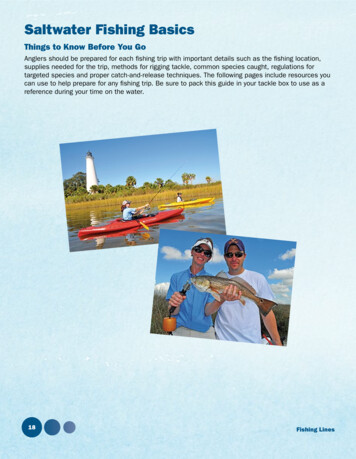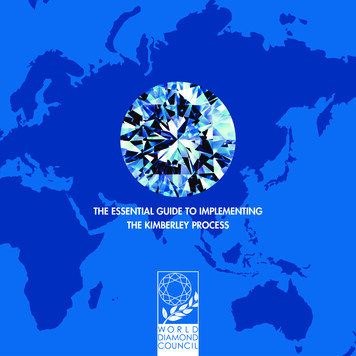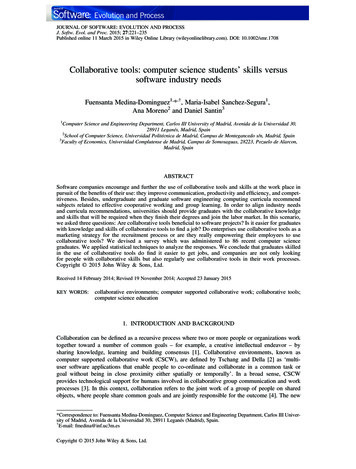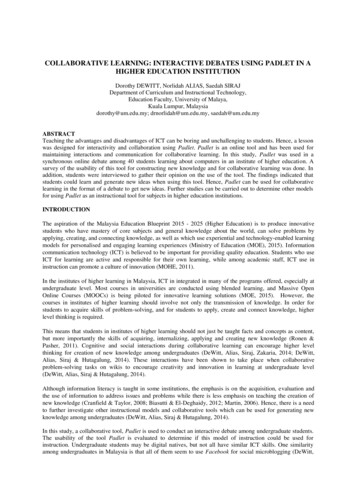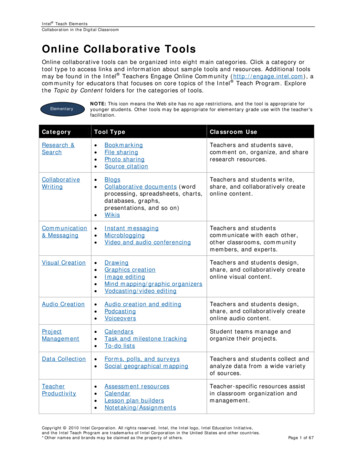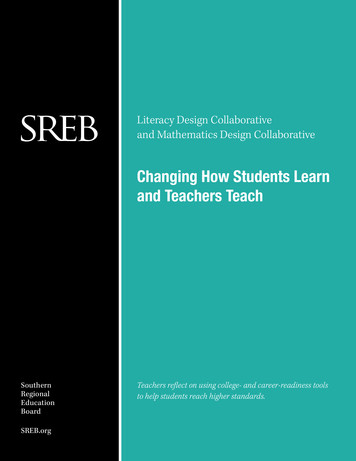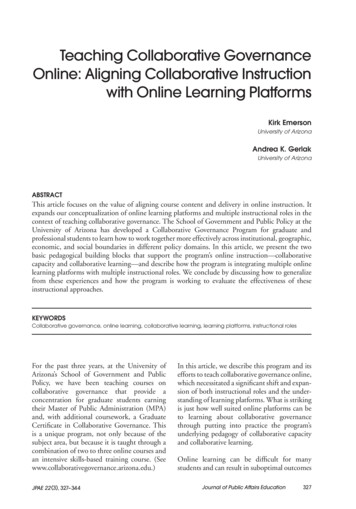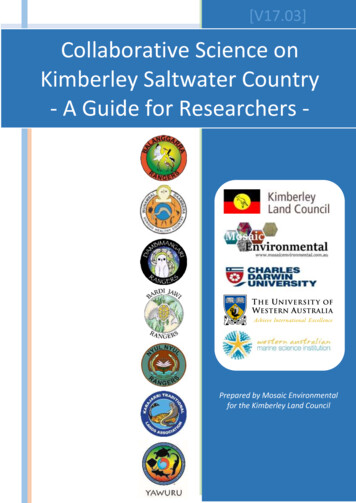
Transcription
[V17.03]Collaborative Science onKimberley Saltwater Country- A Guide for Researchers dambimWGPrepared by Mosaic Environmentalfor the Kimberley Land Council
Suggested citation:Lincoln, G., B.J. Austin, R.J. Dobbs, D. Mathews, D. Oades, A. Wiggan, S. Bayley, J. Edgar, T. King, K.George, J. Mansfield, J. Melbourne, T. Vigilante with the Balanggarra, Bardi Jawi, Dambimangari,Karajarri, Nyul Nyul, Wunambal Gaambera & Yawuru Traditional Owners (2017) CollaborativeScience on Kimberley Saltwater Country - A Guide for Researchers V17.03. Prepared by the KimberleyLand Council for the Kimberley Indigenous Saltwater Science Project (KISSP), Western AustralianMarine Science Institute (WAMSI). Broome July 2017Gina Lincoln1, 2, Beau Austin3, 4, Rebecca Dobbs5, Dean Mathews6, Daniel Oades2, Albert Wiggan2, SamBayley2, Joe Edgar7, Thomas King7, Kevin George8, James Mansfield9, Julie Melbourne6 & Tom Vigilante101 MosaicEnvironmental Consulting.Land Council.3 Research Institute for the Environment and Livelihoods, Charles Darwin University.4 Commonwealth Scientific & Industrial Research Organisation (CSIRO).5 Centre of Excellence for Natural Resource Management, University of Western Australia.6 Nyamba Buru Yawuru.7 Karajarri Traditional Land Association.8 Bardi Jawi Niimidiman Aboriginal Corporation.9 Dambimangari Aboriginal Corporation.10 Bush Heritage Australia.2 KimberleyAuthor contact:Gina LincolnPrincipal Consultant, Mosaic saicenvironmental.com.auPO Box 122 Broome, Western Australia 67250427 655 434Copyright:1. A Creative Commons (CC BY-NC-SA 3.0 AU) licence applies to this document2. Intellectual property remains the property of contributing partners to the KimberleyIndigenous Saltwater Science Project as per the WASMI 1.5 Project Agreement3. All photographs remain copyright of the organisations stated in individual figure titlesQuick links:ContentsStage 1Stage 2Stage 3Stage 4Stage 5Stage 61
LimitationsThis document should be used only for the purpose specified herein. Information is provided ingood faith as a basis for moving forward into a more collaborative research space. No part of it islegally binding on Indigenous Rangers, Traditional Owners or their representatives.This Guide should not be applied to other research types or to research in areas belonging toIndigenous groups not specified herein without the specific direction of the relevant PrescribedBody Corporate for the area of interest.At the discretion of individual Indigenous Groups and their Prescribed Body Corporate, it may beapplied to proposed cinematography or other filming projects.Quick links:ContentsStage 1Stage 2Stage 3Stage 4Stage 5Stage 62
ContentsIntroduction to this Guide. 5Essential Concepts . 9Collaborative Research . 9What if my research project isn’t collaborative? . 12Fee for Service work . 13Multidisciplinary research programs . 14Emergency research. 15Understanding local governance structures . 16Getting Started. 19Stage 1 - Preparing for Research. 20Stage 2 – Developing the project plan together & application . 24Stage 3 - Assessment & Consultation . 29Stage 4 - Agreement Brokerage . 32Stage 5 - Working on Country . 36Stage 6 - Communicating Results. 41Summary of work required by stages . 46Indigenous research partners & their Country . 47Kimberley-wide resources & information. 48Balanggarra people . 49Wunambal Gaambera (Uunguu) people . 50Dambimangari people. 51Bardi Jawi people . 52Nyul Nyul people . 53Yawuru people . 54Karajarri people. 55Key terms . 56Forms . 85List of figures . 86References . 87Quick links:ContentsStage 1Stage 2Stage 3Stage 4Stage 5Stage 63
Key termsAccompaniment by the right people. 56Alcohol-free research environment . 57Camping and accommodation . 57Communication aids . 57Conduct . 58Consultation with Traditional Owners . 58Country . 59Critical Agreement Terms . 59Intellectual Property . 61Publishing the Research . 62Acknowledgement . 63Confidential Information. 64Liability and Insurance . 65Accompaniment . 66Cultural Advisor. 67Ethics approvals . 67First Point of Contact (FPOC) . 67Free, prior informed consent (FPIC) . 68Importance of spending time with people . 70Indigenous Protected Areas (IPAs) . 70Indigenous Rangers . 70Joint Management . 71Kimberley Indigenous Saltwater Science Project (KISSP) . 73Kimberley Land Council (KLC) . 75KLC Land & Sea Management Unit (LMSU) . 75KLC Research Ethics and Access Committee (REAC) . 76Non-compliance . 76Payment and in-kind contributions . 77In-kind contributions by Indigenous research partners. 77Compensation for work done from Stages 2 - 4 . 77Compensation for work done during stage 5 (field work) . 79Risk management. 80Saltwater Country . 80Timeframes and timelines . 80Quick links:ContentsStage 1Stage 2Stage 3Stage 4Stage 5Stage 64
Introduction to this GuideThe Kimberley region is unique due to its natural wealth and the rich culture of its Indigenouspeople. The region an amazing place to work and visit, with research opportunities not experiencedin other parts of the country.Indigenous Kimberley land & sea managers value the contribution of western science tomanagement of their saltwater County in contemporary Australia, just as researchers withKimberley experience value the contributions of Indigenous knowledge to scientific research.Over time researchers have found that the western science they bring to their research projects isonly one side of the equation, with Indigenous knowledge providing the balance. Experiencedresearchers place high value the input of Traditional Owners, Indigenous Rangers and othertraditional knowledge holders to research projects. They also make good use of the network ofIndigenous people with skills, knowledge, expertise, resources and interest in land and seamanagement and research. In essence, they do collaborative research on Kimberley Country.Collaborative research (working ‘two-ways’) is the best-practice approach supported by Indigenouspeople in this region. It works because it respect both types of knowledge and culture, meets theresearch needs of all research partners and makes best use of available resources.However, achieving good collaborative research has not always been easy for Kimberleyresearchers, particularly those new to working with Indigenous land and sea managers. While therehave been numerous success stories and positive outcomes for all research partners, there havealso been significant challenges to overcome.This Guide has been developed to address shortfalls in the existing processes and to provide someconsistency to researchers embarking on Kimberley coastal or marine research projects.This Guide steps land and sea researchers through the process of doing researchprojects with Indigenous Kimberley saltwater people, providing access to anestablished network of Indigenous land & sea management processionals, deeplyknowledgeable elders and Indigenous Rangers with research & monitoringexperienceIt explains the requirements of researchers planning natural & cultural resource management onKimberley traditional land and is linked to a new online research proposal form. It also acts adatabase of information, helping researchers to learn about Indigenous people and Country andsupporting them as they plan for remote research.One of five complementary productsThis Guide is one of a set of five products developed within the Kimberley Indigenous SaltwaterScience Project that can be used by land and sea researchers with an interest in the Kimberley: Mobilising Indigenous Knowledge for Collaborative Management of Kimberley Saltwater CountryGuidelines for Collaborative Knowledge Work in Kimberley Saltwater CountryCollaborative Science on Kimberley Saltwater Country - A Guide for Researchers (this document)Developing a Regional Framework for Saltwater Monitoring in the KimberleyA toolbox for Saltwater Monitoring in the KimberleyQuick links:ContentsStage 1Stage 2Stage 3Stage 4Stage 5Stage 65
Figure 1. How the five complementary products of the Kimberley Indigenous Saltwater ScienceProject relate to one another.The research cycle at first glanceThe collaborative research process described within this Guide is presented as six core stages, eachrequiring a series of steps to be completed. While these are described in detail in followingsections, the below diagram is included as a first-glance introduction for readers of this Guide. Amore detailed diagram showing the work involved in each stage is available here.Figure 2. Simplified stages of the Collaborative Research Cycle described within this Guide.Quick links:ContentsStage 1Stage 2Stage 3Stage 4Stage 5Stage 66
Where this Guide appliesAs at the time of writing, this Guide applies only to those areas of land and sea that fall within thejurisdiction of partnering Kimberley Aboriginal Corporations (PBCs and RNTBCs) that have agreed tosupport this approach. Nonetheless, the principles imbedded in this Guide will be useful forresearchers considering working in other parts of the Kimberley.It is possible that future versions of this Guide may be developed to include a larger number ofTraditional Owner groups and more inland areas as the processes are tested and refined. Pleaseensure you are working with the most recent version.At the time of writing, this Guide applies tonatural and cultural resource managementresearch proposed in land or waters belonging tothe following Kimberley Indigenous saltwaterpeoples: BalanggarraWunambal GaamberaDambimangariBardi JawiNyul NyulYawuru Karajarri(See map over page)Quick links:ContentsStage 1Stage 2Stage 3Stage 4Stage 5Stage 67
Figure 3 The Kimberley Indigenous Saltwater Groups to whom this Guide appliesQuick links:ContentsStage 1Stage 2Stage 3Stage 4Stage 5Stage 68
Essential ConceptsCollaborative ResearchCollaborative research can be thought of as land and sea research that is jointly owned and run byIndigenous people and their western science research partners in a way that values thecontributions of both groups and builds knowledge together.Collaborative research takes into account the management aspirations of contributing parties,addresses the research needs of both groups and shares the work and funding resources fairly. It isoften referred to as two-way research.Example of collaborativeresearch – mapping dugongpopulationsExample of collaborativeresearch - monitoring snubfindolphin in Roebuck BayExample of collaborativeresearch - Uunguu turtlemonitoring“Our knowledge helps the science work because we know for example when we are doing ourturtle transects we already know if it is too windy or too choppy or if the water is too murky tosee. If the tides are too big. Even when we look from on top we can see which sex it is withoutcatching it. We can tell by the way they swim. Hawksbill swim different to green and flatback.Using that knowledge makes it easier to record the data.”(Indigenous Ranger, 2016)“From an analytical perspective we are working with cutting edge methods, but we relied heavilyon traditional knowledge to find the species we were working on. For some of the species we alsorelied on traditional knowledge to gain a better understanding of reproductive ecology - which isrelevant to how we interpret results”(Kimberley researcher, 2016)There are many and varied benefits of collaborative research practices to western scientists and tothe Kimberley Indigenous research partners alike. Some of the key benefits are detailed in theFigures 6 and 7 below.The co-creation of new knowledge through collaborative research practices is explained in detail in‘Mobilising Indigenous Knowledge for Collaborative Management of Kimberley Saltwater Country’.It is important that you read through this document during the foundational stages of projectdevelopment.Quick links:ContentsStage 1Stage 2Stage 3Stage 4Stage 5Stage 69
Figure 4. Some of the ways in which researchers benefit from undertaking collaborative research with Indigenous Kimberley peopleQuick links:ContentsStage 1Stage 2Stage 3Stage 4Stage 5Stage 610
Figure 5. Some of the ways in which Kimberley Indigenous people benefit from undertaking collaborative research with Western ScientistsQuick links:ContentsStage 1Stage 2Stage 3Stage 4Stage 5Stage 611
What if my research project isn’t collaborative?Almost all land and sea research done in the Kimberley is, by nature and location collaborativeresearch. The approach of ‘working together’ makes best use of available resources in the remoteKimberley region.The Kimberley is almost entirely covered by Native Title determinations or applications, providingTraditional Owners with specific rights across their traditional lands. In the sea, Kimberley marineparks are managed jointly between Traditional Owners and the Department Biodiversity,Conservation and Attractions. Further offshore Commonwealth Marine Reserves will be managedcollaboratively with local Indigenous stakeholders.In international terms, the consultative standard required of parties wishing to undertake activityon land owned by Indigenous people is referred to as free, prior, informed consent. Backed by theUnited Nations, it is an ethical standard that researchers should adhere to when undertakingresearch on Kimberley land and waters.Good research has the potential to improve the way in which land and sea country and all that itcontains, is managed and maintained for the use and enjoyment of future generations. Collaborativeapproaches to research help to ensure these benefits are realised.By involving local Indigenous people in the research project, from development stages right throughto the presentation of results to the wider community, the new knowledge and understandingscreated can live on in the practices of local Indigenous Rangers.In some cases, there may be good argument that an individual research project need not meet therequirements of collaborative research. In such cases, the type of local Indigenous involvementmay change, but this must be negotiated through the first point of contact (FPOC) in each area.Non-collaborative research projects still need to meet minimum criteria, including: Refer to local planning documents to find out how your research could support localpriorities. This is important even if you have a specific project proposal tied to set funding; If it doesn’t support local priorities, you may be able to negotiate to undertake the projecton Country, based around other outcomes. Clear communication about the usefulness ofresearch locally/nationally/internationally is especially important in these cases; Talk to the local FPOC early to discuss your research idea and take their advice on how theproject could be rolled out; Develop a plain English communication aid to explain your proposal to the local PBC Submit a Research Proposal Form (or facilitate a fee for service arrangement if agreed) Sign a research agreement (or fee for service agreement) between your university and PBC Arrange for any logistical support you require with the FPOC Negotiate any in-kind support and/or payments to Cultural Advisors and IndigenousRangers required to work on the research project Develop a plain English communication aid to explain the results of your research to thelocal PBC after the research is completeQuick links:ContentsStage 1Stage 2Stage 3Stage 4Stage 5Stage 612
Fee for Service workSome research projects, or a specific part of them, qualify as a Fee for Service (FFS) arrangementwith the local Ranger Group.If you are proposing research that utilises IndigenousRangers through FFS, you will need to approach the firstpoint of contact (FPOC) in the preferred location todiscuss this arrangement.You are encouraged to familiarise yourself with this Guideand work through Stage 1 (A-G) before making contactwith him/her. This background information will supportthe success of your project and help tailor the FFSarrangements to the local Indigenous Ranger group.The local Ranger Coordinator or IPA Coordinator willprogress your proposal under the direction of their PBC.Considerations include: how well it fits it into the ranger group’s worksschedule for the coming quarter the resources of the Ranger group what benefit to the Rangers of gaining experience inthis type of work any risks perceived cost effectiveness location of field work local community interest in the research topicRegardless of whether it becomes a FFS arrangement or acollaborative research project, it will still need to gothrough a process of consultation and agreementbrokerage.The main differences will be the way in which theresearcher is supported in the field, what type ofapplication form is used, the payment schedule and theagreement type. Usually a FFS agreement will replace astandard research agreement.Figure 6 Nyul Nyul Rangers undertaking marinedebris monitoringExamples of FFS arrangements for research include: Remote tyre changing services for a research team during repeated field trips Annual biodiversity monitoring of a threatened ecological community and data return to theresearch coordinator Opportunistic collection, storage and shipping specific samples of marine mammals whenharvested locally by traditional hunting methods Marine debris monitoring & management activities etc.Quick links:ContentsStage 1Stage 2Stage 3Stage 4Stage 5Stage 613
Multidisciplinary research programsThe intent of this Guide is to support western scientists and Indigenous research partners to developand implement collaborative research projects that have benefit to all parties involved.If your institution is planning a large, multi-researcher or multi-disciplinary research program, youwill need to undertake a higher level of planning and negotiation than is described within this Guide.Once these higher-level arrangements have been made with all local groups, then this Guide willsupport the individual researchers planning their project component.For larger initiatives, you will need to start by ensuring there is appropriate Indigenous Kimberleyrepresentation within the group of people developing and progressing the research programconcept.Send out an introductory email to all of the FPOCs within the area of the proposed research programas well as making direct contact with the regional land & sea manager at the Kimberley Land Council(KLC). Understand that not all Indigenous groups or Indigenous Rangers are affiliated with the KLCand that you will need to develop an appropriate way of facilitating input on a regional-scale.You may have the option of part-funding a meeting of a Kimberley Saltwater Working Group (neeKISSP) comprised of representatives from across Kimberley Saltwater Country to float your idea. Thisgroup cannot make decisions on behalf of their Prescribed Body Corporates (PBC) but instead acts asa conduit of information between researchers and saltwater communities. Its members areknowledgeable land and sea mangers who may also be the FPOC in each region. Speak to the KISSPleadership team members to progress this option.You may also want to make contact with institutional staff who have been involved with thedevelopment of past regional research programmes in the Kimberley to learn from theirexperiences. Initiatives such as the Northern Environmental Science Program and the WesternAustralian Marine Science Institute’s Kimberley Marine Research Program are recent examples.Quick links:ContentsStage 1Stage 2Stage 3Stage 4Stage 5Stage 614
Emergency researchThere are times when research or monitoring is required urgently in response to emergencysituations such as coral bleaching or pollution events. Local Indigenous people recognise the needfor rapid access to Country and quick research assessment processes in these cases.Advice to researchers in this situation is to call the local FPOC to explain the circumstances with asmuch notice as possible. If events are anticipated in any way (for example sustained high oceantemperatures leading to a risk of coral bleaching) be in touch with the FPOC in each area underpotential threat to raise your concerns early on. They can help get local eyes and ears on the area ofconcern, help identify issues as they arise and can support contingency planning.If the local FPOC is in the field and unavailable, you can make contact with the FPOC of theneighbouring area for advice on who best to contact next. For groups affiliated with the KimberleyLand Council, you can also call their regional land & sea manager as a starting point.If the issue is a regional one, you may have the option of part-funding a meeting of a KimberleySaltwater Working Group (nee KISSP) comprised of representatives from across Kimberley SaltwaterCountry to float your idea. This group cannot make decisions on behalf of PBCs but instead acts as aconduit of information between researchers and communities. Its members are knowledgeable landand sea mangers who may also be the FPOC in each region. Speak to the KISSP leadership teammembers to progress this option.Figure 7 Coral bleaching on Scott Reef (Photo courtesy Nick Thake, Australian Institute of MarineScience, 2016)Quick links:ContentsStage 1Stage 2Stage 3Stage 4Stage 5Stage 615
Understanding local governance structuresIt is important to understand the basics of local governance structures that apply to Kimberleytraditional lands before starting your collaborative research journey. Please take some time to readabout Native Title, Aboriginal Corporations and Traditional Owners before starting work on Stage 1.Traditional OwnershipA Traditional Owner (commonly referred to as a TO) is a person who possesses joint responsibilitiesof an area of land and/or waters through the system of land ownership and obligation used byIndigenous Australians for many thousands of years. The mechanisms determining traditionalownership are complex and are beyond the scope of this document to explain.However, some important points for researchers to understand include: Country is owned jointly by Traditional Owners from a family group, or as shared traditionalestate, but not all family members are Traditional Owners Knowledge about Country is held collectively, with different people holding differentknowledge and old people being the greatest repository of knowledge for their Country Being an oral culture, people rely on each other to hold and to check their recollection toensure accuracyThese are some of the reasons that a number of Traditional Owners need to be consulted aboutproposed research projects and why researchers may need to be accompanied by more than theminimum standard of one TO and one Indigenous Ranger in some cases.Figure 8. Karajarri dancers at the Karajarri Indigenous Protected Area declaration (photo courtesyKimberley Land Council, 2016)Quick links:ContentsStage 1Stage 2Stage 3Stage 4Stage 5Stage 616
Native TitleNative Title provides recognition within contemporary Australian law of the unbroken occupationof Country by a related group of Indigenous people going back before sovereignty. For successfulclaimants, a lengthy process of court hearings and
The Kimberley region is unique due to its natural wealth and the rich culture of its Indigenous people. The region an amazing place to work and visit, with research opportunities not experienced in other parts of the country. Indigenous Kimberley land & sea managers value the contribution of western science to
